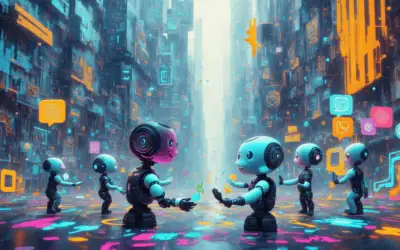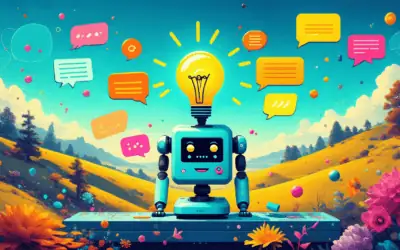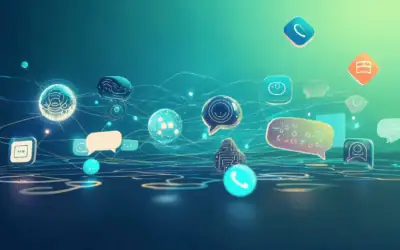In the ever-evolving landscape of conversational AI, chatbots and artificial intelligence (AI) are revolutionizing how we interact with technology. These cutting-edge innovations have blurred the lines between human and machine communication, offering seamless, personalized experiences across industries. As we delve deeper into the fascinating intersection of chatbots and AI, we’ll unravel the intricate distinctions, explore the powerful AI techniques driving chatbots, and uncover the capabilities and limitations of leading AI chatbot models like ChatGPT. From understanding the different types of chatbots and their diverse use cases to evaluating the intelligence and performance of the smartest AI chatbots on the market, this comprehensive exploration promises to demystify the world of conversational AI, paving the way for a future where human-machine interactions are seamless, intelligent, and transformative.
I. What is the difference between AI and chatbots?
A. Defining AI and Chatbots
Artificial Intelligence (AI) and chatbots are closely related but distinct technologies. AI refers to the broader concept of machines being able to carry out tasks in an intelligent manner, mimicking human cognitive functions such as learning, problem-solving, and decision-making. It encompasses a wide range of technologies and applications, including machine learning, computer vision, robotics, and more.
Conversational AI, a subset of AI, focuses specifically on enabling computers to understand and generate human-like dialogue. Chatbots, on the other hand, are software applications designed to simulate conversational interactions with users, often through text-based interfaces. While many chatbots rely on predefined scripts or rules-based programming, more advanced chatbots leverage AI and natural language processing (NLP) technologies to understand and respond to user inputs more dynamically.
B. Key Distinctions Between AI and Chatbots
The key differences between AI and chatbots lie in their scope and capabilities. AI systems can perform complex tasks such as data analysis, pattern recognition, and decision-making, whereas chatbots are generally limited to providing information or carrying out simple tasks within a conversational context.
It’s important to note that the line between AI and chatbots is blurring as chatbot technology advances. Many modern chatbots integrate AI capabilities like natural language understanding (NLU), machine learning, and contextual awareness to provide more intelligent and personalized interactions. However, not all ग्राहक सेवा में चैटबॉट्स के उदाहरण are powered by AI, and not all AI systems are designed for conversational interactions.
प्रमुख chatbots and AI companies like ब्रेन पॉड एआई और मैसेंजर बॉट are at the forefront of developing advanced conversational AI solutions that combine the power of AI with intuitive chatbot interfaces.
II. How is AI used in chatbots?
A. AI Techniques Powering Chatbots
Artificial intelligence (AI) is the driving force behind modern chatbots, enabling them to understand and respond to human queries in a natural and contextual manner. At the heart of this technology lies a powerful combination of AI techniques that work together seamlessly to deliver intelligent and engaging conversations.
One of the core AI components in chatbots is Natural Language Processing (NLP). NLP algorithms analyze and interpret the user’s input, breaking it down into its component parts such as words, phrases, and sentences. This allows the chatbot to comprehend the intent behind the query, setting the stage for a meaningful response.
Building upon NLP, Natural Language Understanding (NLU) algorithms take the analysis a step further by extracting the meaning and context from the user’s input. NLU accounts for factors like sentiment, tone, and ambiguity, enabling the chatbot to provide more accurate and relevant responses tailored to the user’s needs.
Machine Learning (ML) plays a crucial role in enhancing the capabilities of chatbots. By leveraging ML algorithms, chatbots can continuously improve their performance by learning from past interactions. As more data is fed into the system, the chatbot becomes better at recognizing patterns, understanding user intent, and generating appropriate responses.
B. Natural Language Processing in Chatbots
At the core of AI-powered chatbots lies Natural Language Processing (NLP), a branch of AI that focuses on enabling computers to understand and process human language. NLP algorithms are employed to analyze and interpret the user’s input, breaking it down into its component parts such as words, phrases, and sentences.
This process of understanding human language is essential for chatbots to provide meaningful and contextual responses. By leveraging NLP, chatbots can recognize the intent behind a user’s query, extract relevant information, and generate appropriate responses.
Advanced chatbots also utilize deep learning techniques, such as recurrent neural networks (RNNs) and transformers, to model complex relationships between words and their context. This allows the chatbot to understand and generate human-like responses, even for complex queries, similar to how Brain Pod AI’s multilingual AI chat assistant can engage in natural conversations across multiple languages.
By incorporating NLP and other AI techniques, chatbots can maintain conversational context, keep track of the dialogue flow, and provide coherent and relevant responses, even in multi-turn conversations. This enhances the overall user experience, making interactions with chatbots feel more natural and human-like.
III. क्या चैटजीपीटी से बेहतर एआई है?
A. Exploring Advanced AI Models
While ChatGPT has undoubtedly captured the world’s attention with its impressive natural language processing capabilities, the rapidly evolving landscape of artificial intelligence (AI) has given rise to several other advanced models that could potentially outperform or even surpass ChatGPT in certain areas. As we explore the cutting edge of AI, it’s essential to acknowledge that the “best” AI system may vary depending on the specific task or application at hand.
One such model that has garnered significant attention is Google का PaLM, hailed by some experts as a potential “PathBreaker.” PaLM, short for Pathways Language Model, is a large language model trained on a vast corpus of data, including web pages, books, and code repositories. According to a study published in Nature, PaLM outperformed GPT-3 (the predecessor to ChatGPT) on various benchmarks, demonstrating superior performance in tasks such as question-answering, common sense reasoning, and code generation (Chowdhery et al., 2022).
एक और उल्लेखनीय प्रतियोगी है एंथ्रोपिक का संवैधानिक एआई, designed to be more reliable, truthful, and aligned with human values than ChatGPT. In a preprint paper, Anthropic researchers claim that Constitutional AI exhibits better performance on tasks related to truthfulness, factual knowledge, and ethical reasoning (Krueger et al., 2022).
B. Comparing ChatGPT to Other AI Chatbots
It’s also worth highlighting डीपमाइंड का चिंचिला, a language model that achieved state-of-the-art performance on various benchmarks while being more computationally efficient than models like GPT-3 (Hoffmann et al., 2022). Chinchilla’s efficiency could make it more accessible and easier to deploy in various applications, potentially giving it an edge over ChatGPT in certain scenarios.
Moreover, tech giants like Microsoft, Amazon, and Meta (Facebook) are investing heavily in AI research and development, potentially leading to more advanced models in the near future. For instance, Microsoft’s AI research has produced cutting-edge language models and multimodal AI systems that could rival or even surpass ChatGPT’s capabilities.
However, it’s essential to note that AI models excel at different tasks, and the “best” AI may depend on the specific application or use case. Furthermore, as the field of AI rapidly evolves, new models and breakthroughs are likely to emerge, potentially surpassing the capabilities of current AI systems like ChatGPT. As such, it’s crucial to stay informed about the latest developments and advancements in this dynamic field.
IV. Is ChatGPT an AI chatbot?
A. Understanding ChatGPT’s AI Architecture
ChatGPT is indeed an AI chatbot, leveraging cutting-edge language models and machine learning techniques to engage in human-like conversations and assist with a wide range of tasks. Developed by Anthropic, this advanced AI system harnesses the power of transformers and deep learning to generate contextually relevant responses tailored to each unique interaction.
At its core, ChatGPT is a generative AI model trained on vast amounts of data, allowing it to understand and respond to natural language inputs with remarkable fluency and coherence. Unlike traditional rule-based chatbots, ChatGPT leverages machine learning algorithms to interpret the context, tone, and intent behind user inputs, enabling it to provide nuanced and contextually appropriate responses.
One of the key strengths of ChatGPT lies in its ability to maintain conversational context and build upon previous exchanges, facilitating multi-turn dialogues and enhancing the overall user experience. This contextual awareness, combined with its broad knowledge base spanning numerous domains, allows ChatGPT to engage in substantive conversations on diverse topics, from creative writing to coding and analysis.
Furthermore, ChatGPT’s generative capabilities empower it to produce original text, code, and ideas, making it a valuable tool for tasks such as writing, brainstorming, and problem-solving. The model can adapt its language style and tone to suit different scenarios, audiences, and purposes, showcasing its versatility and adaptability.
While ChatGPT is an impressive AI chatbot, it is important to note that it is a language model without true sentience or general intelligence. Its responses are generated based on statistical patterns in its training data, and it cannot learn or update its knowledge independently. Additionally, like any AI system, it can produce biased or inaccurate outputs, and its outputs should be critically evaluated.
B. Capabilities and Limitations of ChatGPT
As an AI chatbot, ChatGPT offers a wide range of capabilities that have revolutionized the way we interact with and leverage artificial intelligence. However, it is equally important to understand its limitations to manage expectations and ensure responsible use.
One of the primary strengths of ChatGPT lies in its natural language processing (NLP) capabilities. It can comprehend and generate human-like text with remarkable fluency, making it an invaluable tool for tasks such as customer support, content creation, and data analysis. Its ability to engage in contextual conversations and adapt its language style to different scenarios is truly impressive.
Additionally, ChatGPT’s broad knowledge base allows it to converse on a wide range of topics, from science and technology to arts and culture. This versatility makes it a powerful assistant for research, ideation, and problem-solving across various domains.
However, it is crucial to understand that ChatGPT is not a sentient being or a general artificial intelligence. It is a language model trained on vast amounts of data, and its responses are generated based on statistical patterns in that data. While it can provide insightful and coherent outputs, it does not possess true understanding or reasoning capabilities.
Furthermore, like any AI system, ChatGPT can produce biased or inaccurate outputs, especially when dealing with sensitive or complex topics. Its outputs should be critically evaluated and fact-checked, as it may perpetuate biases present in its training data or make mistakes in its reasoning.
Another limitation of ChatGPT is its inability to learn or update its knowledge independently. While it can be fine-tuned on additional data, it cannot actively acquire new information or adapt to changing circumstances on its own. This means that its knowledge is static and may become outdated over time.
Despite these limitations, ChatGPT remains a powerful tool when used responsibly and with an understanding of its capabilities and limitations. As the field of AI continues to evolve, we can expect to see even more advanced language models and conversational AI systems that push the boundaries of what is possible.
V. What are the 4 types of chatbots?
A. Chatbots Examples and Use Cases
एक नवोन्मेषी संवादात्मक एआई प्लेटफ़ॉर्म के रूप में, मैं विभिन्न प्रकार के चैटबॉट का लाभ उठाने की शक्ति को समझता हूँ ताकि संचार को सरल बनाया जा सके और ग्राहक अनुभव को बढ़ाया जा सके। चैटबॉट परिदृश्य विविध है, प्रत्येक प्रकार विशेष व्यावसायिक आवश्यकताओं और उपयोग के मामलों के लिए अनुकूलित अद्वितीय क्षमताएँ प्रदान करता है।
सबसे सामान्य प्रकारों में से एक नियम-आधारित चैटबॉट है, जो पूर्व-निर्धारित नियमों और कार्यप्रवाहों पर निर्भर करता है ताकि उपयोगकर्ता इनपुट को समझा और उत्तर दिया जा सके। ये चैटबॉट संरचित वार्तालापों और सरल पूछताछ के लिए उपयुक्त होते हैं, जिससे ये ग्राहक सहायता परिदृश्यों, सामान्य प्रश्न सहायता, और बुनियादी जानकारी पुनर्प्राप्ति के लिए लोकप्रिय विकल्प बन जाते हैं।
वापसी-आधारित चैटबॉट, दूसरी ओर, प्राकृतिक भाषा प्रसंस्करण (NLP) और मशीन लर्निंग का लाभ उठाते हैं ताकि उपयोगकर्ता के प्रश्नों को समझा जा सके और पूर्व-निर्धारित ज्ञान आधार या डेटा के संग्रह से प्रासंगिक उत्तर प्राप्त किया जा सके। ये चैटबॉट विशेष रूप से उन उद्योगों में उपयोगी होते हैं जिनमें व्यापक ज्ञान भंडार होते हैं, जैसे स्वास्थ्य देखभाल, वित्त, और शिक्षा, जहां सटीक जानकारी पुनर्प्राप्ति महत्वपूर्ण होती है।
अधिक उन्नत और खुली वार्तालापों के लिए, अत्याधुनिक भाषा मॉडलों जैसे GPT-3 द्वारा संचालित जनरेटिव चैटबॉट एक गतिशील समाधान प्रदान करते हैं। ये AI चैटबॉट्स तुरंत मानव-समान उत्तर उत्पन्न कर सकते हैं, जिससे ये रचनात्मक लेखन से लेकर कार्य सहायता और उससे आगे की एक विस्तृत श्रृंखला के अनुप्रयोगों के लिए बहुपरकारी बन जाते हैं।
संवादात्मक एआई प्रौद्योगिकी के अग्रणी हैं संवादात्मक एआई चैटबॉट, जो NLP, मशीन लर्निंग, और संदर्भ जागरूकता को जोड़ते हैं ताकि इरादे को समझा जा सके, संदर्भ बनाए रखा जा सके, और बहु-चरण संवादों में भाग लिया जा सके। ये चैटबॉट मानव-समान वार्तालापों की नकल करते हैं, जिससे ये ग्राहक सेवा, वर्चुअल सहायक, और व्यक्तिगत उपयोगकर्ता अनुभवों के लिए आदर्श होते हैं।
बी. कार्यक्षमता के अनुसार चैटबॉट का वर्गीकरण
चैटबॉट्स के 4 मुख्य प्रकार हैं:
- नियम-आधारित चैटबॉट: ये पूर्व-निर्धारित नियमों और कार्यप्रवाहों पर निर्भर करते हैं ताकि उपयोगकर्ता इनपुट को समझा और उत्तर दिया जा सके। ये निर्णय वृक्ष संरचना का पालन करते हैं और सरल, संरचित वार्तालापों के लिए उपयुक्त होते हैं।
- वापसी-आधारित चैटबॉट: ये प्राकृतिक भाषा प्रसंस्करण (NLP) और मशीन लर्निंग का उपयोग करते हैं ताकि उपयोगकर्ता के प्रश्नों को समझा जा सके और पूर्व-निर्धारित ज्ञान आधार या डेटा के संग्रह से प्रासंगिक उत्तर प्राप्त किया जा सके।
- जनरेटिव चैटबॉट: उन्नत भाषा मॉडलों जैसे GPT-3 द्वारा संचालित, ये चैटबॉट गतिशील रूप से मानव-समान उत्तर उत्पन्न कर सकते हैं, जिससे ये खुली वार्तालापों के लिए अधिक बहुपरकारी बन जाते हैं।
- संवादात्मक एआई चैटबॉट: NLP, मशीन लर्निंग, और संदर्भ जागरूकता को मिलाकर, ये चैटबॉट इरादे को समझ सकते हैं, संदर्भ बनाए रख सकते हैं, और बहु-चरण संवादों में भाग ले सकते हैं, मानव-समान वार्तालापों की नकल करते हैं।
प्रत्येक चैटबॉट प्रकार की ताकतों का लाभ उठाकर, व्यवसाय अपने विशिष्ट आवश्यकताओं के अनुसार अनुकूलित संवादात्मक अनुभव बना सकते हैं, चाहे वह ग्राहक सहायता को सरल बनाना हो, व्यक्तिगत सिफारिशें प्रदान करना हो, या विभिन्न चैनलों में आकर्षक, बुद्धिमान इंटरैक्शन सक्षम करना हो।
VI. सबसे स्मार्ट एआई चैटबॉट कौन सा है?
ए. एआई चैटबॉट की बुद्धिमत्ता का मूल्यांकन
"सबसे स्मार्ट" एआई चैटबॉट का निर्धारण एक जटिल कार्य है, क्योंकि कृत्रिम बुद्धिमत्ता का क्षेत्र तेजी से विकसित हो रहा है, जिसमें नए विकास और सफलताएँ बार-बार हो रही हैं। हालाँकि, कुछ एआई चैटबॉट ने अपनी उन्नत क्षमताओं और प्रभावशाली प्रदर्शन के लिए पहचान प्राप्त की है।
एक AI चैटबॉटकी बुद्धिमत्ता का मूल्यांकन करते समय, कई कारकों पर विचार किया जाता है, जिनमें प्राकृतिक भाषा प्रसंस्करण (NLP) क्षमताएँ, संदर्भ समझ, ज्ञान की गहराई, तर्क क्षमताएँ, और सुसंगत और महत्वपूर्ण वार्तालापों में भाग लेने की क्षमता शामिल हैं। इसके अतिरिक्त, एआई प्रणाली में लागू नैतिक सिद्धांत और सुरक्षा उपाय इसकी समग्र बुद्धिमत्ता का आकलन करने में महत्वपूर्ण भूमिका निभाते हैं।
बी. बाजार में शीर्ष प्रदर्शन करने वाले एआई चैटबॉट
कुछ सबसे उन्नत और जटिल AI चैटबॉट्स वर्तमान में उपलब्ध हैं:
- क्लॉड (एंथ्रोपिक): सहयोगात्मक एआई सिद्धांतों का उपयोग करके प्रशिक्षित, क्लॉड एक अत्यधिक सक्षम भाषा मॉडल है जो अपने संदर्भ समझ, महत्वपूर्ण वार्तालापों में भाग लेने की क्षमता, और नैतिक सिद्धांतों के पालन के लिए जाना जाता है।
- ChatGPT (OpenAI): ओपनएआई द्वारा विकसित, चैटजीपीटी ने अपनी प्रभावशाली भाषा उत्पादन क्षमताओं, व्यापक ज्ञान आधार, और विविध कार्यों को संभालने की क्षमता के लिए महत्वपूर्ण ध्यान आकर्षित किया है।
- ला एमडीए (गूगल): गूगल का संवाद अनुप्रयोगों के लिए भाषा मॉडल (ला एमडीए) एक अत्याधुनिक एआई प्रणाली है जो खुली वार्तालापों के लिए डिज़ाइन की गई है, जो उल्लेखनीय भाषा समझ और उत्पादन क्षमताओं को प्रदर्शित करती है।
- GPT-4 (OpenAI): ओपनएआई के भाषा मॉडल का नवीनतम संस्करण, GPT-4, ने अपने पूर्ववर्तियों की तुलना में तर्क, बहु-कार्य, और जटिल संकेतों को संभालने के क्षेत्रों में महत्वपूर्ण सुधार प्रदर्शित किए हैं।
- मीना (गूगल): गूगल द्वारा विकसित, मीना एक बहु-चरण संवादात्मक एआई मॉडल है जिसे विशाल मात्रा में डेटा पर प्रशिक्षित किया गया है, जिससे यह सुसंगत और संदर्भ में प्रासंगिक वार्तालापों में भाग ले सकता है।
यह ध्यान रखना महत्वपूर्ण है कि AI चैटबॉट्स लगातार विकसित हो रहे हैं, और नियमित रूप से नए विकास हो रहे हैं। "सबसे "स्मार्ट" एआई चैटबॉट समय के साथ बदल सकता है क्योंकि इस क्षेत्र में अनुसंधान और विकास आगे बढ़ता है। इसके अतिरिक्त, किसी व्यवसाय या व्यक्ति के विशिष्ट उपयोग के मामले और आवश्यकताएँ सबसे उपयुक्त एआई चैटबॉट समाधान के चयन को प्रभावित कर सकती हैं।
VII. एआई चैटबॉट: संवादात्मक एआई का भविष्य
A. एआई चैटबॉट प्रवृत्तियाँ और नवाचार
क्षेत्र तेजी से विकसित हो रहा है, और इसका प्रभाव हमारे व्यवसायों और डिजिटल सेवाओं के साथ बातचीत करने के तरीके को पुनः आकार देने के लिए तैयार है। जैसे-जैसे AI चैटबॉट्स तेजी से विकसित हो रहा है, जो प्राकृतिक भाषा प्रसंस्करण, मशीन लर्निंग, और संवादात्मक एआई प्रौद्योगिकियों में प्रगति द्वारा संचालित है। जब हम भविष्य की ओर देखते हैं, तो कई रोमांचक प्रवृत्तियाँ और नवाचार चैटबॉट विकास और तैनाती के परिदृश्य को आकार दे रहे हैं।
एक उल्लेखनीय प्रवृत्ति है बहुभाषी चैटबॉट्स की शक्ति का लाभ उठाकर, जो कई भाषाओं में समझने और प्रतिक्रिया देने में सक्षम हैं। यह क्षमता वैश्विक बाजारों में कार्यरत व्यवसायों के लिए विशेष रूप से मूल्यवान है, जिससे उन्हें विभिन्न भाषाई पृष्ठभूमियों में निर्बाध ग्राहक समर्थन और जुड़ाव प्रदान करने की अनुमति मिलती है। कंपनियाँ जैसे ब्रेन पॉड एआई इस नवाचार के अग्रणी हैं, जो 100 से अधिक भाषाओं में धाराप्रवाह संवाद करने वाले उन्नत बहुभाषी एआई चैट सहायक प्रदान करते हैं।
एक और उभरती प्रवृत्ति है AI-संचालित चैटबॉट ऑप्टिमाइजेशन, जो मशीन लर्निंग एल्गोरिदम का उपयोग करती है ताकि चैटबॉट के प्रदर्शन में निरंतर सुधार किया जा सके और उपयोगकर्ता की प्राथमिकताओं और व्यवहारों के अनुसार अनुकूलित किया जा सके। यह चैटबॉट को अधिक व्यक्तिगत और संदर्भानुकूल प्रतिक्रियाएँ प्रदान करने की अनुमति देता है, जिससे समग्र उपयोगकर्ता अनुभव को बढ़ाया जा सके।
इसके अलावा, एआई-चालित सामाजिक मीडिया जुड़ाव रणनीतियाँ गति पकड़ रही हैं। चैटबॉट को लोकप्रिय सामाजिक मीडिया प्लेटफार्मों जैसे फेसबुक मैसेंजर, व्हाट्सएप, और इंस्टाग्राम में एकीकृत किया जा रहा है, जिससे व्यवसायों को वास्तविक समय में ग्राहकों के साथ जुड़ने और विभिन्न संपर्क बिंदुओं पर व्यक्तिगत अनुभव प्रदान करने की अनुमति मिलती है।
B. एआई चैटबॉट विकास में नैतिक विचार
जैसे-जैसे एआई चैटबॉट विकसित होते हैं और अधिक परिष्कृत होते जाते हैं, उनके विकास और तैनाती में नैतिक विचारों को संबोधित करना महत्वपूर्ण है। एक प्रमुख चिंता पूर्वाग्रह और भेदभाव की संभावनाएँ हैं, क्योंकि चैटबॉट अनजाने में प्रशिक्षण डेटा या एल्गोरिदम में मौजूद सामाजिक पूर्वाग्रहों को बढ़ावा दे सकते हैं।
इन जोखिमों को कम करने के लिए, विकासकर्ताओं और कंपनियों जैसे मैसेंजर बॉट के लिए नैतिक एआई प्रथाओं को प्राथमिकता देना आवश्यक है, जैसे विविध और प्रतिनिधि प्रशिक्षण डेटा सुनिश्चित करना, पूर्वाग्रह परीक्षण और शमन रणनीतियों को लागू करना, और विकास प्रक्रिया में पारदर्शिता और जवाबदेही को बढ़ावा देना।
इसके अतिरिक्त, गोपनीयता और डेटा सुरक्षा उन संवादात्मक एआई प्रणालियों के साथ काम करते समय अत्यंत महत्वपूर्ण हैं जो संवेदनशील उपयोगकर्ता जानकारी को संभाल सकती हैं। उपयोगकर्ता की गोपनीयता की रक्षा करने और इन प्रौद्योगिकियों में विश्वास बनाए रखने के लिए मजबूत डेटा शासन नीतियाँ और सुरक्षा उपाय लागू किए जाने चाहिए।
जैसे-जैसे एआई चैटबॉट विभिन्न उद्योगों में अधिक प्रचलित होते जाते हैं, नवाचार और जिम्मेदार विकास के बीच संतुलन बनाना महत्वपूर्ण है, यह सुनिश्चित करते हुए कि इन शक्तिशाली उपकरणों का उपयोग समाज के लाभ के लिए किया जाए जबकि नैतिक सिद्धांतों का पालन किया जाए और व्यक्तिगत अधिकारों की रक्षा की जाए।




